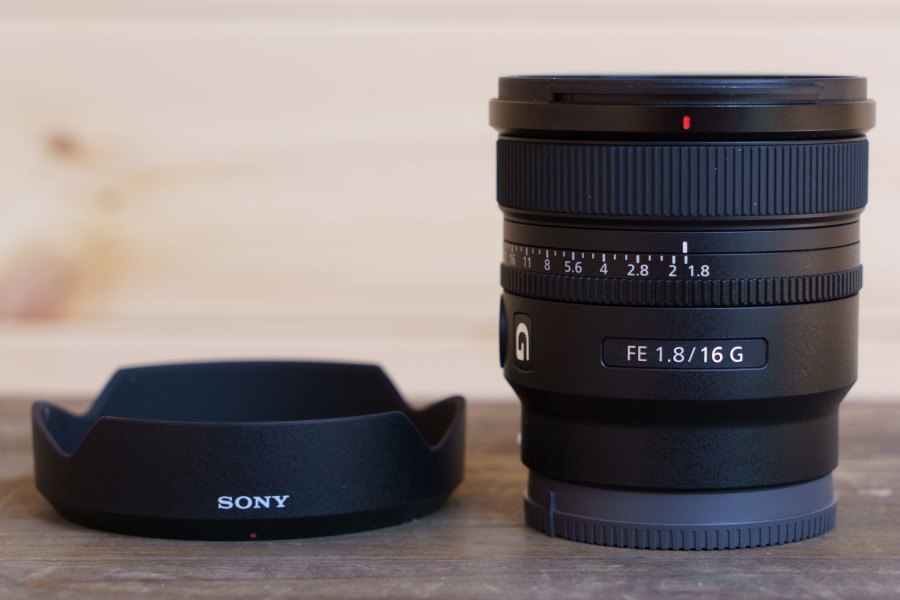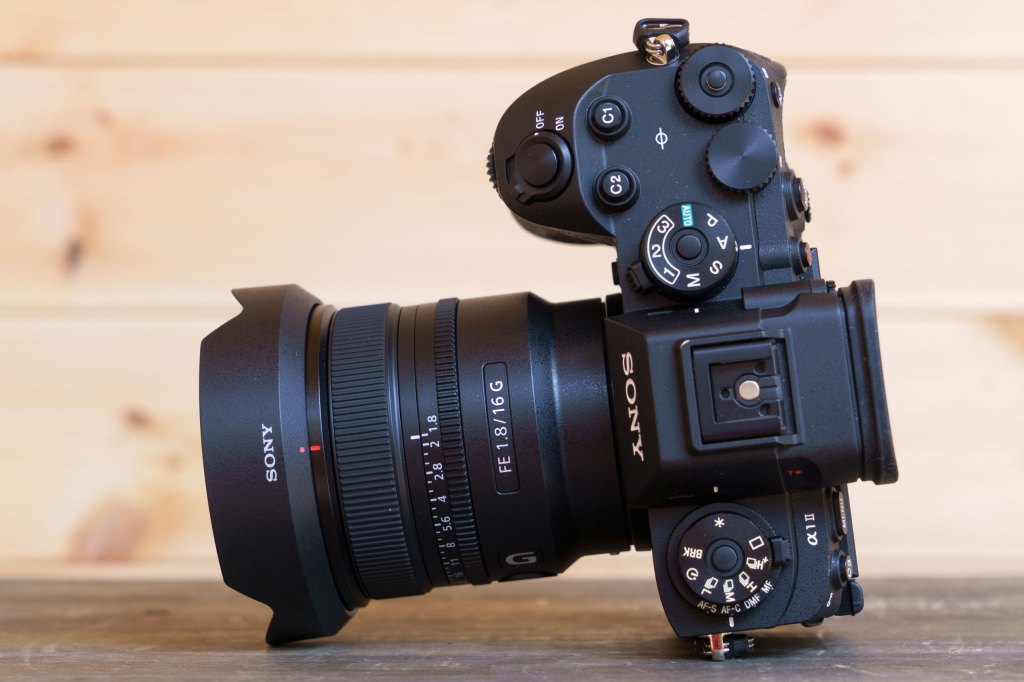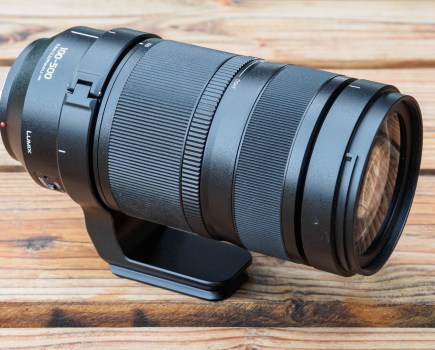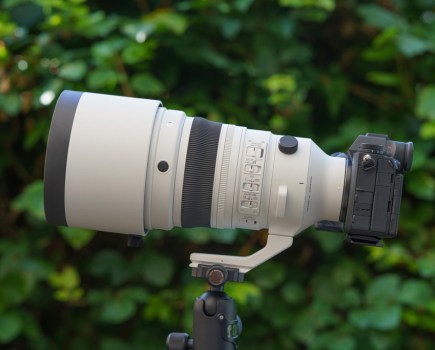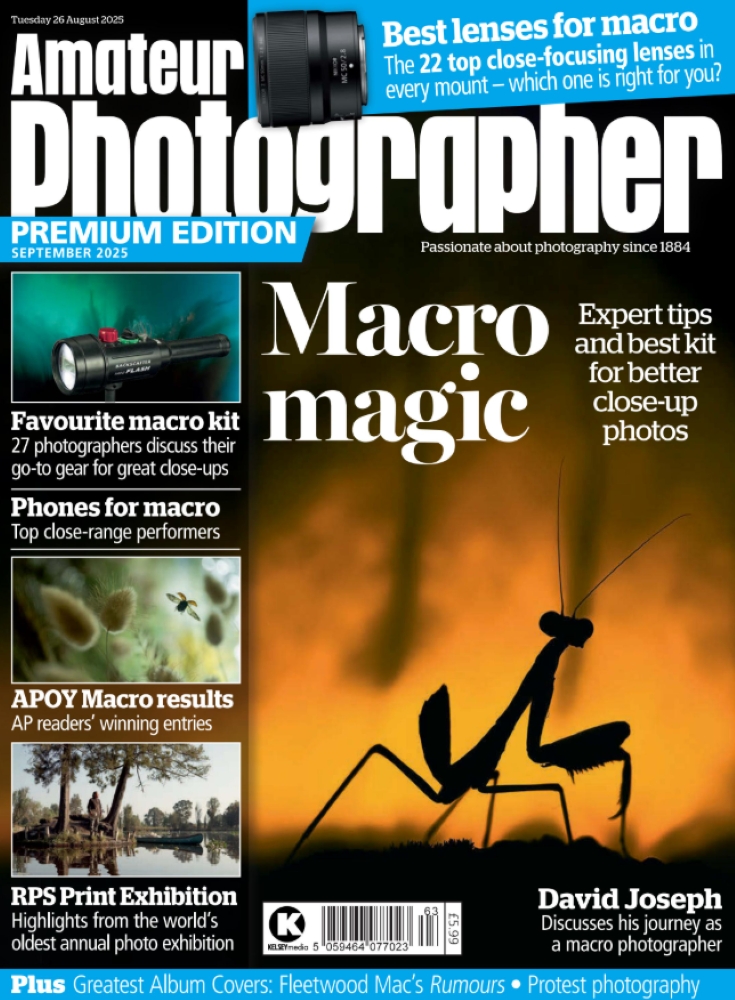Amateur Photographer verdict
The Sony FE 16mm F1.8 G is a a capable ultra-wide-angle lens that delivers great performance in a compact form- Lightweight and compact
- Fast, quiet autofocus
- Accepts standard filters
- Bokeh highlights can be harsh
- Some corner softness at small apertures
The Sony FE 16mm F1.8 G is a fixed focal length lens designed for use on Sony’s full-frame E-mount cameras. It’s part of Sony’s G series, which means it offers strong optical performance at a more affordable price than that of Sony’s top-flight G Master optics, at $800 / £850. As an ultra-wide lens, it provides a 107-degree angle of view on full-frame bodies and 83 degrees on APS-C format cameras where it behaves like a 24mm lens in full-frame terms. This makes it an attractive choice for wide-angle landscape, street, travel and astro photography, or for shooting inside when space is tight. It could also be a nice choice for arm’s length vlogging.
Sony FE 16mm F1.8 G at a glance:
- Lens Mount: Sony FE
- Aperture: f/1.8 – f/22
- Lens: 15 elements in 12 groups
- Min Focus: 0.15m (AF), 0.13m (MF)
- Filter thread: 67mm
- Dimensions: 75 x 73.8mm
- Weight: 304g

Sony FE 16mm F1.8 G – Features
The FE 16mm F1.8 G’s optical construction comprises 15 elements arranged in 12 groups, with, three Extra-low Dispersion (ED) elements, one Super ED element and three Aspherical elements, two of which are Advanced Aspherical (AA) elements. As usual, this configuration is designed to deliver sharp, high-contrast images while minimising chromatic aberration and distortion. Advanced optical coatings reduce flare and ghosting, helping to maintain contrast and clarity in challenging lighting conditions, while the fluorine coating on the front element helps it to shed water droplets and dirt.
Unusually for such a portable wideangle, this lens has a fast f/1.8 maximum aperture. As well as allowing more light in to maintain high shutter speeds in low light, this enables relatively shallow depth-of-field effects for subject separation when the focus distance is short. The iris is formed from 11 blades and retains a circular shape throughout its range, to deliver better quality out-of-focus areas.
The lens also has a pair of XD (Extreme Dynamic) Linear Motors that are designed to ensure quiet and responsive autofocus, making it equally well suited to stills and video work. Further good news is that the lens supports Sony’s (focus) Breathing Compensation function which is available on many of Sony’s recent cameras. This helps to keep the field of view consistent when shifting the focus during video recording. Focusing is internal.
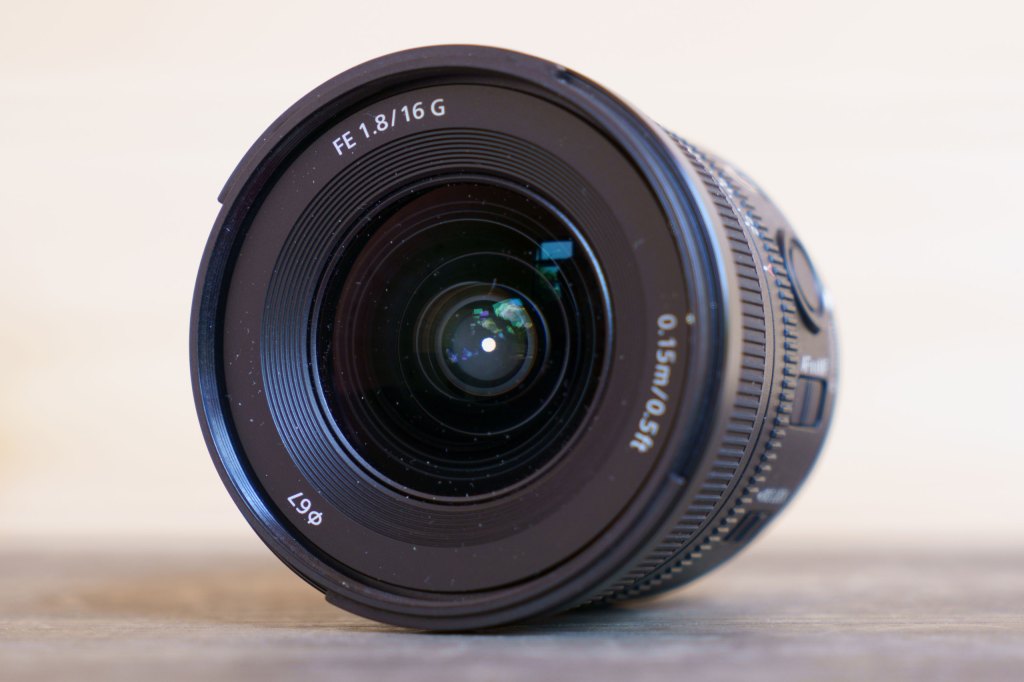
Although the lens isn’t stabilised, it’s compatible with Sony’s in-body stabilisation, including the Active and Dynamic Active modes that help to steady footage when shooting video handheld or on the move. Conveniently, and unlike some ultra-wide lenses, there’s a front thread that accepts 67mm filters, rather than requiring rear-mounted gel filters.
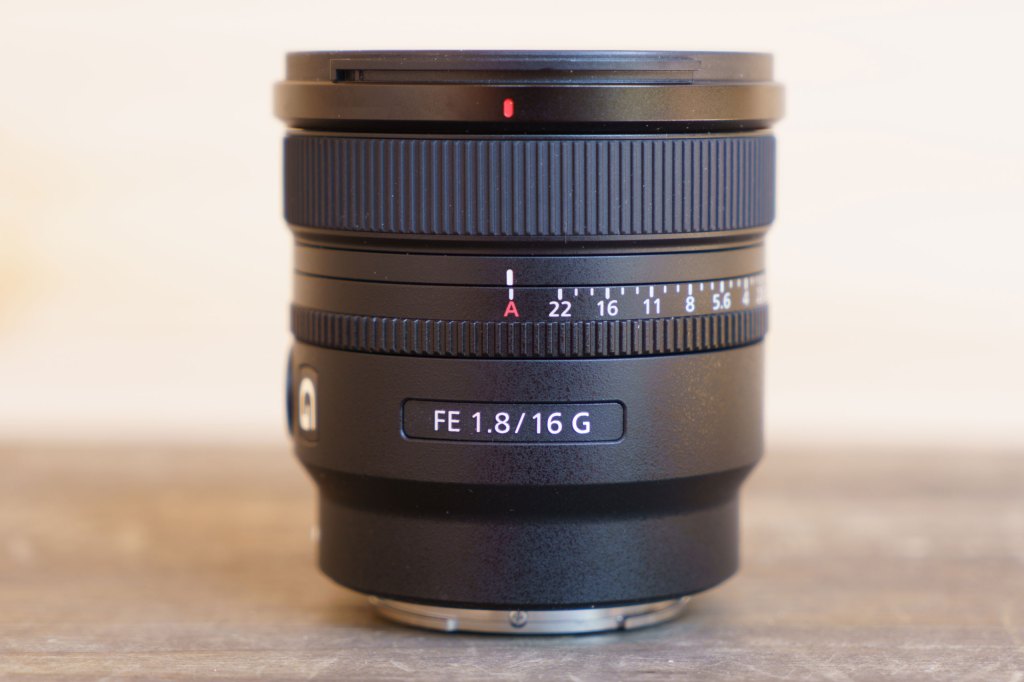
Sony FE 16mm F1.8 G – Build and Handling
Despite its fast aperture, the Sony FE 16mm F1.8 G is pleasantly compact, measuring just 75mm in length and 73.8mm in diameter. It also weighs just 304g. Consequently, it pairs nicely with both Sony’s larger full-frame bodies such as the A1 II and smaller options like the A7CR.
In addition, the lens is weather-sealed, with gaskets around its moving parts and, as mentioned earlier, a fluorine coating on the front element to helps repel water and fingerprints. This makes the FE 16mm F1.8 G a good choice for outdoor photography in unpredictable weather. I used the lens on a day out in Birmingham during which I encountered a mixture of sunshine and showers, and it survived the experience giving no cause for concern.
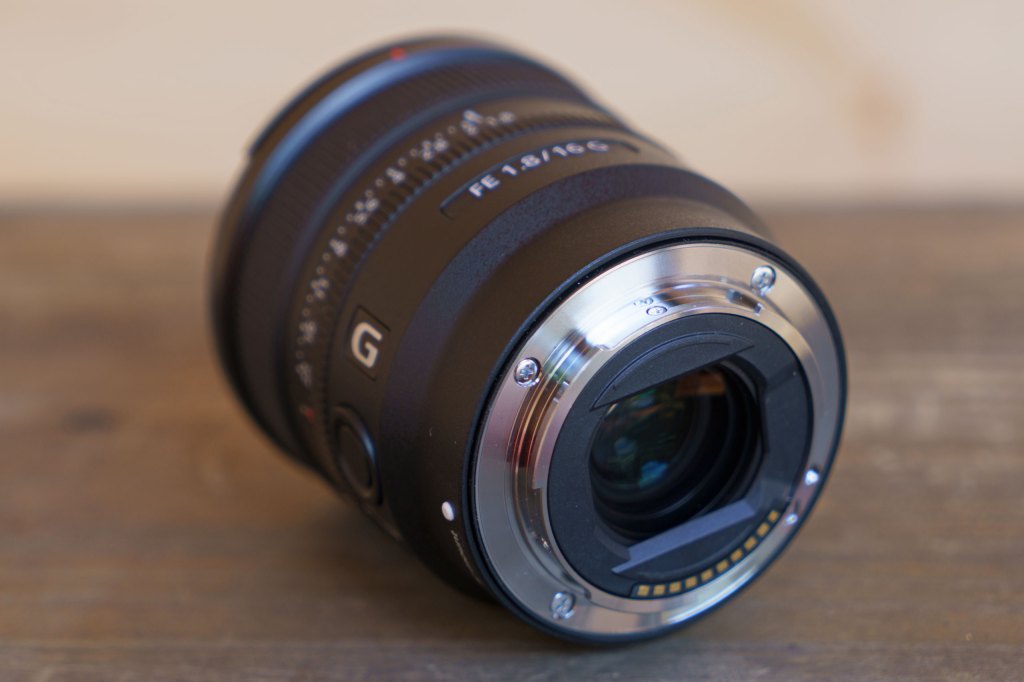
The barrel has an aperture ring which can be ‘de-clicked’ for smooth, silent operation during video shooting. When the switch is set to ‘click’, you get clear feedback at every 1/3 stop as the ring rotates through its range from f/1.8 to f/22. There’s also an iris lock that prevents accidental switching between the automatic and manual aperture settings.
Above the iris lock, there’s a switch for toggling between autofocus and manual focus, and a customisable focus hold button. Meanwhile, the narrow focus ring sits towards the front of the barrel. This operates electronically and uses Sony’s Linear Response MF system to give a predictable response based on the rotation angle of the ring, rather than its speed of movement. This makes manual focusing feel more intuitive, but as usual, there are no physical end points to the focus adjustment. I find the movement of this ring a little on the loose side, but it means that you can use one finger to tweak the focus point.
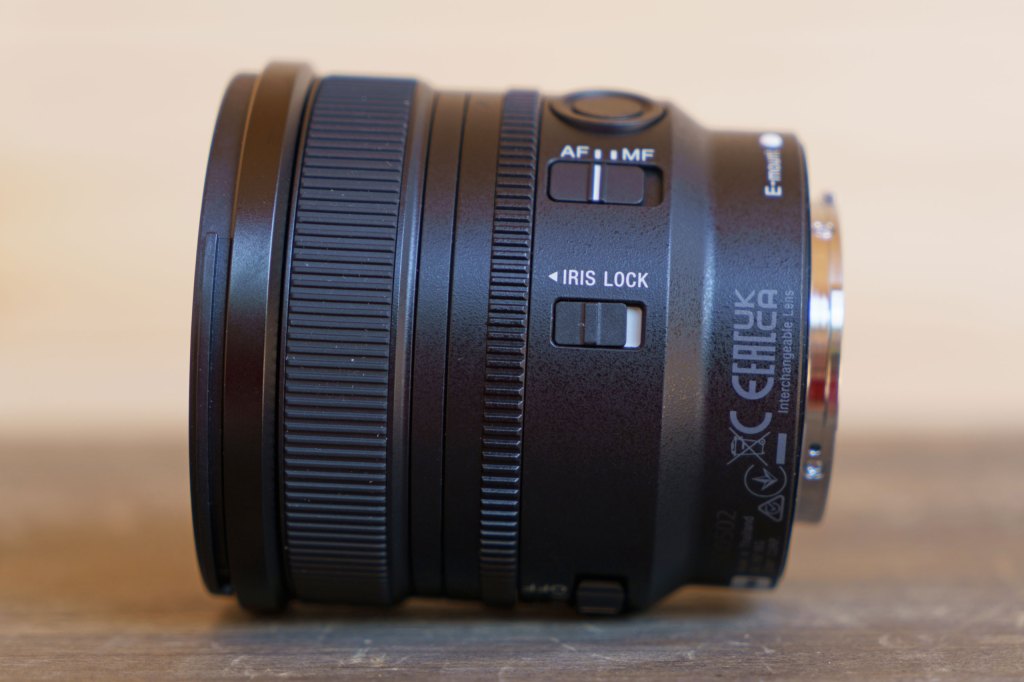
Unlike some manufacturers (I’m looking at you, Canon), Sony includes a petal-shaped hood with the lens, which helps prevent flare and offers a bit of protection from knocks and raindrops.
Sony FE 16mm F1.8 G – Autofocus
I used the Sony FE 16mm F1.8 G on the Sony Alpha A7R V, A1 II and A7CR cameras, and the autofocus is fast and accurate on all three bodies. It locks on quickly and quietly, even in low light, and it’s effective when photographing close subjects. The lens supports Sony’s subject detection and eye AF systems and proves reliable in tracking moving subjects, even when working near the minimum focus distance.
The dual XD Linear Motors ensure near-silent operation, which is valuable when recording video or photographing in quiet environments. They also ensure the lens changes focus smoothly, avoiding the sudden shifts that can spoil footage. That, paired with Sony’s very capable focusing and subject detection systems, means that you can be confident that your subject is tracked accurate in most situations.

Even on the Sony A7R IV, which doesn’t have Sony’s Breathing Compensation technology, focus breathing is minimal.
The lens’ minimum focusing distance is just 15cm with autofocus and slightly closer at 13cm when focusing manually, enabling you to get very near your subject for exaggerated perspectives and creative framing. This opens up the potential for dramatic close-ups that maintain context – a technique I enjoy a lot.
Sony FE 16mm F1.8 G – Image Quality
The Sony FE 16mm F1.8 G delivers impressive sharpness across the frame at all but the smallest apertures. Centre sharpness is strong from f/1.8 and improves slightly on stopping down, with the best corner-to-corner results typically seen at around f/2.8 to f/8. There is some softening due to diffraction at f/16 and f/22, most visible in the corners, but this is unlikely to be a concern during typical usage. Those seeking edge-to-edge performance should shoot at mid-range apertures to get consistently good results.

Uncorrected raw files show noticeable barrel distortion, but this is effectively corrected in-camera for JPEGs and by lens profiles in raw processing software. Vignetting is well controlled, with just a subtle darkening in the corners at f/1.8. It shouldn’t pose an issue for most users.
Chromatic aberration is also managed well and despite hunting around high contrast edges in my images, I couldn’t find any fringing. The lens also handles flare well, especially with the supplied petal-shaped hood attached. Even when the sun is in the frame, or casting light across the front element, there’s only the odd hot spot or mild ghosting.
Out-of-focus areas are rendered reasonably smoothly, however, the small highlights can look a little harsh, with noticeable edge definition and occasional onion-ring patterns. This is most evident when bright points of light appear near the frame edges.
Sony FE 16mm F1.8 G – Verdict
The Sony FE 16mm F1.8 G offers photographers and videographers a capable ultra-wide-angle lens that delivers great performance in a compact form. Its handling is excellent, with intuitive manual focusing and useful external controls, while the weather-sealed design ensures durability for outdoor use. In addition, the autofocusing is fast, quiet and accurate, and the image quality is very good overall, particularly in the f/2.8 to f/11 range.
The image sharpness, even wide open, is pleasing, and corner-to-corner consistency is impressive by f/2.8. The lens’s ability to focus very close to subjects adds further versatility, allowing photographers to explore unusual perspectives. Video shooters will also appreciate the quiet, smooth focusing and minimal breathing, alongside features like the de-clickable aperture ring and 67mm screw-on filter compatibility.
While the bokeh rendering is not as refined as that of some other lenses, and there is some softness at the smallest apertures (especially in the corners), these are minor drawbacks in the context of an otherwise very well-rounded lens.
At around $800 / £850, the Sony FE 16mm F1.8 G is a compelling option for anyone in need of a fast, compact ultra-wide prime without stepping up to a G Master model. It strikes a strong balance between performance, portability and price, and it’s likely to appeal to a broad range of users, including vloggers, landscape and cityscape photographers.

Sony FE 16mm F1.8 G – Specifications
| Lens mount | Sony FE |
| Filter Diameter | 67mm |
| Lens Elements | 15 |
| Groups | 12 |
| Diaphragm Blades | 11 |
| Aperture | f/1.8 – f/22 |
| Min Focus | 0.15m (AF), 0.13m (MF) |
| Length | 75mm |
| Diameter | 73.8mm |
| Weight | 304g |
| Lens Mount | Sony FE |
| Included Accessories | Lens caps, petal-shaped hood |
Related reading:
- Sigma 16mm F1.4 DC DN C review
- Sony’s New Zeiss FE 16-35mm f4 Wide Angle Zoom lens
- Sony unveils ultra-wideangle FE 14mm F1.8 GM

